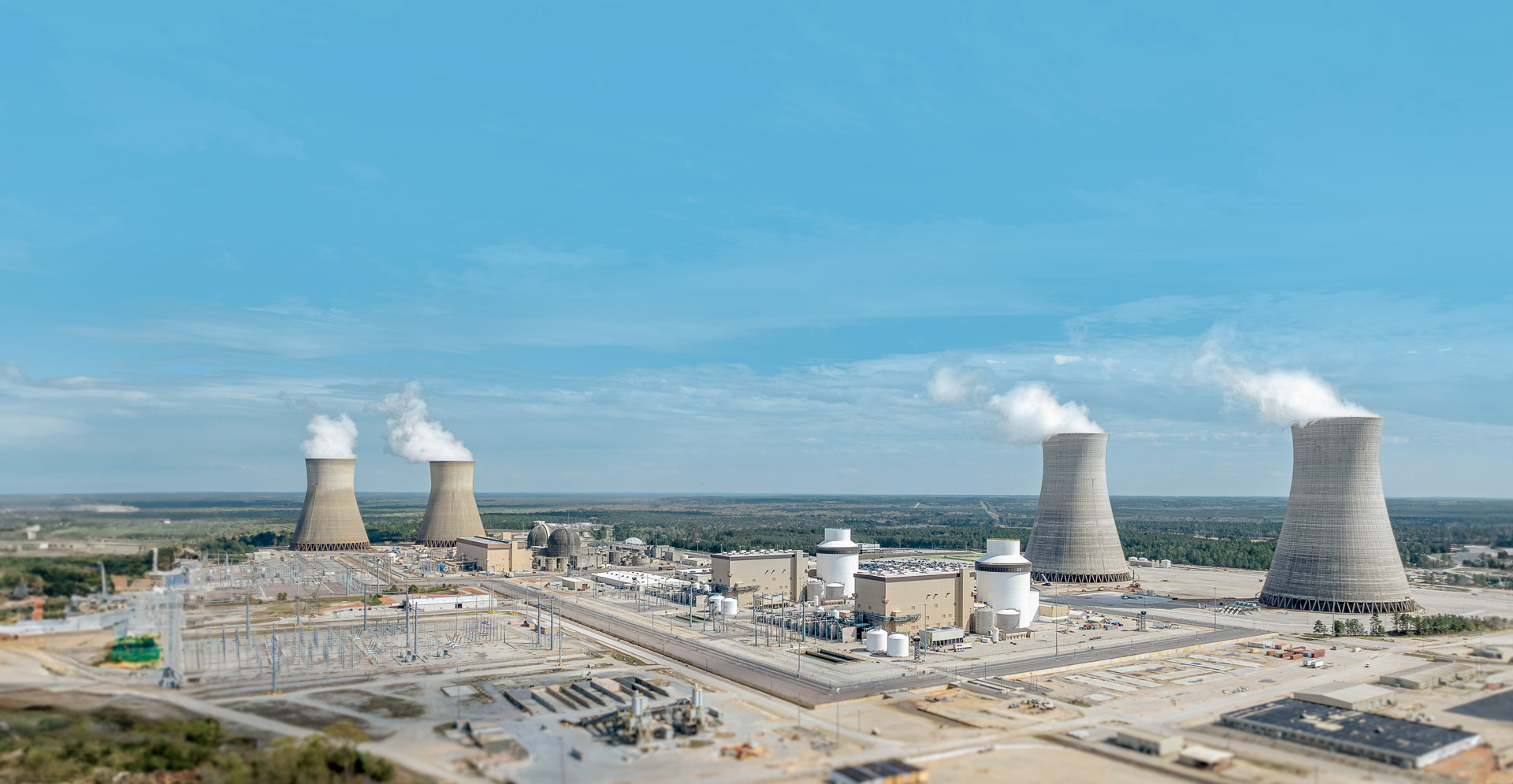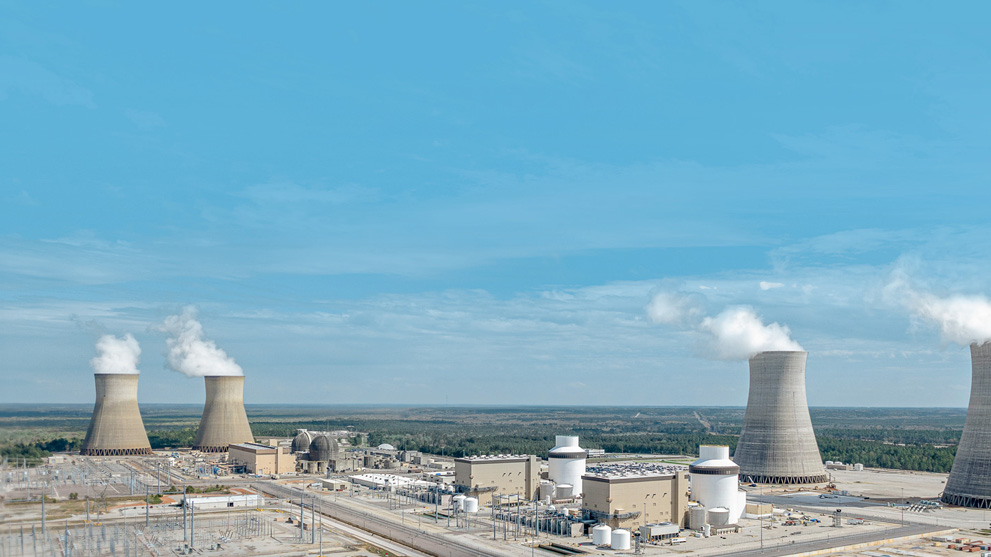Plant Vogtle Units 3 & 4 are the first newly constructed nuclear units to be built in the United States in more than 30 years.
America's newest nuclear reactors will not only provide clean, safe, reliable, and affordable energy for millions of Georgians, but also hundreds of jobs.
At peak construction, more than 9,000 workers were on site.
Clean Energy
The fuel source for nuclear power plants is uranium, but unlike coal, gas, and oil, uranium does not burn chemically, making the process completely carbon-free.
This is where water plays an especially critical role at nuclear energy facilities.
Water is pumped in and vaporized from the heat produced by the splitting of atoms in a process called fission. Turbines, powered by steam, then turn to produce electricity.
Water is also pushed through the reactor to cool it down as well as to cool used fuel. The latter occurs in a 40-foot-deep steel-lined pool filled with borated water, which acts as a natural barrier to radiation.
Did you know?
Water is pumped through more than 100 miles of piping throughout Units 3 & 4.
The cloud that you see rising from the cooling towers? That's excess water vapor!

A Next Generation Reactor
The AP1000 is a two-loop pressurized water reactor that uses a simplified, innovative, and effective approach to safety.
Vogtle Units 3 & 4 are the first Westinghouse AP1000 Plants to be built in the United States. Drawn from 50 years of successful operating experience.
The reactor vessel and internals, steam generator, fuel and pressurizer designs are improved versions of those found in older models of currently operating Westinghouse-designed PWRs. The reactor’s cooling system utilizes canned-motor pumps, the type used in many other industrial applications where reliability and long life are paramount.
Westinghouse AP1000 Reactor

The AP1000 is a two-loop pressurized water reactor that uses a simplified, innovative, and effective approach to safety.
Vogtle Units 3 & 4 are the first Westinghouse AP1000 Plants to be built in the United States. Drawn from 50 years of successful operating experience.
The reactor vessel and internals, steam generator, fuel and pressurizer designs are improved versions of those found in older models of currently operating Westinghouse-designed PWRs. The reactor’s cooling system utilizes canned-motor pumps, the type used in many other industrial applications where reliability and long life are paramount.
Safety Measures
We take the health and safety of our employees, the public, and the environment very seriously.
Plant Vogtle is designed with redundant safety systems and multiple layers of protection – including structural strength, highly trained operators and proven emergency plans.

Why steel and concrete?
By using thick layers of hydrogen-containing materials such as concrete or water in addition to dense steel plates, potentially harmful radiation is contained within the plant’s structures, creating a safe and secure environment and allowing us to generate clean energy 24 hours a day, seven days a week.
Safety Measures
We take the health and safety of our employees, the public, and the environment very seriously. Plant Vogtle is designed with redundant safety systems and multiple layers of protection – including structural strength, highly trained operators and proven emergency plans.
Regulatory Oversight
Full-time, on-site inspectors from the U.S. Nuclear Regulatory Commission (NRC) monitor the plant to ensure it is maintained and operated safely and in accordance with established nuclear operating procedures. The NRC holds nuclear plants to the highest security standards of any American industry.
Emergency Preparedness
In the unlikely event of an emergency, Plant Vogtle has comprehensive plans that define and assign responsibilities and outline an effective course of action for safeguarding personnel, property and the general public. These plans are updated regularly and maintained at all times. Drills and exercises are conducted frequently to test these plans and train plant personnel.
Did you know?
The volume of the concrete used for construction could build a 3,375 mile sidewalk from Miami to Seattle.

Did you know?
The 23,000 tons of structural steel required to build Vogtle Units 3 & 4 is enough to build 25,000 cars.

Nuclear Energy – Efficient & Effective
Out of the 11,000 utility-scale electric power plants currently operating in the United States, less than 60 are nuclear power plants. Despite this seemingly small number, nuclear energy accounts for around 20% of all energy, and around 50% of all emission-free energy generated across the country.
There are currently two nuclear plants in operation in Georgia – Plant Hatch and Plant Vogtle – and with the addition of Units 3 & 4, Plant Vogtle is now the largest nuclear power station in the United States.

What is the fuel made of?
Plant Vogtle generates heat with the use of ceramic pellets made of uranium. The uranium ore is mined, processed, enriched and formed into cylindrical fuel pellets.
Did you know?
A single 1/2 inch Uranium Nuclear Fuel Pellet creates as much energy as:
149 gallons of oil
17,000 ft3 of natural gas
2,000 lbs of coal ore
Did you know?
For a windfarm to produce the same amount of energy as Plant Vogtle, it would need to cover an area over 1000 square miles.

Monumental Construction Achievements
The construction of the additional units at Plant Vogtle represented one of the largest and most important infrastructure investment projects in the United States.
Did you know?
Each of the reactor vessels for Units 3 & 4 weigh more than the Statue of Liberty – 600,000 lbs each.
Each cooling tower stands 60 stories tall.
The building where the modules were assembled was large enough to contain 1,620 school buses – 10 stories tall and as long as a football field.

Learn more about Plant Vogtle

What is the fuel made of?
Plant Vogtle generates heat with the use of ceramic pellets made of uranium. The uranium ore is mined, processed, enriched and formed into cylindrical fuel pellets.
The pellets, each about the size of a pencil eraser, are arranged in long vertical tubes bundled together to form one fuel assembly. There are 157 fuel assemblies in each reactor at Vogtle Units 3 & 4.
Our uranium fuel does not burn chemically. The heat needed to create steam comes from the splitting of atoms, a process called fission, inside each pellet.
Fission occurs when a uranium atom absorbs a neutron and the atom splits to create heat. Additional neutrons are also released, and they go on to split more atoms, creating a sustainable chain reaction.


